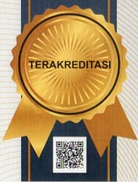Efektifitas dan Efisiensi Penggunaan Klorinator sebagai Sarana Pelarut Disinfektan di Usaha Kecil dan Menengah (UKM)
Abstract
Water is an important substances in the food industry. The quality of water that is used in the small Industry (UKM) generally has bad quality. This is caused by lack of knowledge and cost. The aim of the study was to evaluate effectiveness and efficiency of using chlorinator as disinfectan (chlorine) solvent in the small industry (UKM). This study used complete randomized design with 2 repetitions and analyzed water quality before and after treatment. The parameters that was used was coliform and eschericia coli (e. coli) contaminant and total chlorine in the water. The cost efficiency was calculated with evaluate chlorine/m3. Results showed a decrease of coliform and E.coli (p<0.05), from 2,3 x105 cfu/100 ml to 0 cfu/ml for both. Furthermore, total chlorine after treatment showed no decrease significantly (p<0.05). The cost efficiency of using chlorinator was cheap, just Rp. 916/m3. The use of chlorinator was effective to decrease total microbiology contaminant and can keep total chlorine concentration in the standard of water quality for hygiene and sanitation. Furthermore, chlorinator was also efficience in cost to be implemented in small industry (UKM)
Full Text:
PDF (Bahasa Indonesia)References
Wahlquist ÅK. Water and its role in food and health security – the importance of water to food production. Asia Pac J Clin Nutr;18(4):501-6. 2009.
Oberholster PJ, Botha A-M. The importance of water quality to the food industry in South Africa. Understanding the Food Energy Water Nexus WWF-SA, South Africa. 2014.
BPS. Statistik Air Bersih. 2015 Badan Pusat Statistik Republik Indonesia.
BPS. Hasil Survei Kualitas Air di Daerah Istimewa Yogyakarta. 2015, Badan Pusat Statistik Republik Indonesia.
Makvana S, Krilov LR. Escherichia coli Infections. Pediatrics in review;36(4):167-70; quiz 71. 2015.doi :10.1542/pir.36-4-167.
PERMENKES. Peraturan Menteri Kesehatan Republik Indonesia Nomor 32 Tahun 2017 tentang Standar Baku Mutu Kesehatan Lingkungan dan Persyaratan Kesehatan Air Untuk Keperluan Higiene Sanitasi, Kolam Renang, Solus Per Aqua, Dan Pemandian Umum. Dinas Kesehatan Republik Indonesia. 2017.
Nuraida L. Keamanan Pangan Industri Usaha Kecil Dan Menengah (UKM) dan Industri Rumah Tangga (IRT) Pangan Seafast Institut Pertanian Bogor. 2008.
Farzin YH, Grogan KA. Socioeconomic factors and water quality in California. Environmental Economics and Policy Studies;15(1):1-37. 2013.
Van Haute S, Sampers I, Holvoet K, Uyttendaele M. Physicochemical quality and chemical safety of chlorine as a reconditioning agent and wash water disinfectant for fresh-cut lettuce washing. Applied and environmental microbiology;79(9):2850-61. 2013. doi :10.1128/AEM.03283-12.
BSN. SNI 7828:2012 Kualitas air – Pengambilan contoh - Bagian 5 : Pengambilan contoh air minum dari instalasi pengolahan air dan sistem jaringan distribusi Perpipaan. Badan Standardisasi Nasional. 2012.
BSN. SNI 3554 : 2015 Cara uji air minum dalam kemasan. Badan Standarisasi Nasional. 2015.
Juhna T, Birzniece D, Larsson S, Zulenkovs D, Sharipo A, Azevedo NF, et al. Detection of Escherichia coli in biofilms from pipe samples and coupons in drinking water distribution networks. Applied and environmental microbiology;73(22):7456-64. 2007. doi : 10.1128/AEM.00845-07.
Hosni AA, Szabo JG, Bishop PL. Efficacy of Chlorine Dioxide as a Disinfectant for Bacillus Spores in Drinking-Water Biofilms. J Environ Eng;137:569-74,2011.doi: 10.1061/(ASCE)EE. 19437870.0000355.©2011.
Denisova V, Mezule L, Juhna T. The Effect of Chlorination on Escherichia Coli Viability in Drinking Water. Material Science and Applied Chemistry;30:45. 2014.10.7250/msac.2014.008.
Zhao T, Doyle MP, Zhao P, Blake P, Wu F-M. Chlorine Inactivation of Escherichia coli O157:H7 in Water. Journal of Food Protection;64(10):1607–9. 2001.
Moreno, Y., Piqueres, P., Alonso, J. L., et al. Survival and viability of Helicobacter pylori after inoculation into chlorinated drinking water. Water Research, vol. 41, N 15, pp.3490–3496. 2007, doi : http://dx.doi.org/10.1016/j.watres .2007.05.02
Zhao, T., Doyle, M. P., Zang, P., et al. Chlorine inactivation of Escherichia coli O157: H7 in water. Journal of Food Protection, 2001, vol. 64, N 10, pp. 1607–1609.
National Toxicology Program (NTP). Toxicology and Carcinogenesis Studies of Chlorinated Water (CAS Nos. 7782-50-5 and 7681-52-9) and Chloraminated Water (CAS No. 10599-90-3) (Deionized and CharcoalFiltered) in F344/N Rats and B6C3F1 Mice (Drinking Water Studies). TR-392. 1992.
DOI: https://doi.org/10.32487/jst.v5i1.630
Refbacks
- There are currently no refbacks.
Copyright (c) 2019 JST (Jurnal Sains Terapan)
View My Stats


